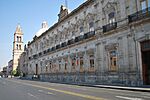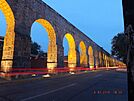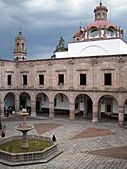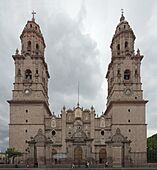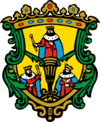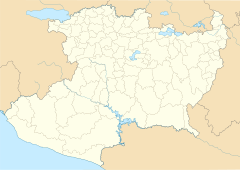Morelia facts for kids
Quick facts for kids
Morelia
|
|||
|---|---|---|---|
|
City
|
|||
|
Panoramic of Morelia
College of San Nicolás
Chapel of Our Lady of Guadalupe
Equestrian statue of José María Morelos
Federal Palace
Aqueduct of Morelia
Clavijero Cultural Center
|
|||
|
|||
| Country | |||
| State | Michoacán | ||
| Municipality | Morelia | ||
| Founded | 1541 | ||
| Name change Valladolid → Morelia | 1828 | ||
| Municipality Founded | 1831 | ||
| Founded by | Antonio de Mendoza | ||
| Named for | José María Morelos y Pavón | ||
| Elevation | 6,300 ft (1,920 m) | ||
| Population
(2020) Municipality
|
|||
| • City | 849,053 | ||
| • Urban | 1,002,461 | ||
| • Metro | 1,060,708 | ||
| • Seat | 597,511 | ||
| GDP (PPP, constant 2015 values) | |||
| • Year | 2023 | ||
| • Total | $18.3 billion | ||
| • Per capita | $18,500 | ||
| Time zone | UTC−6 (CST) | ||
| • Summer (DST) | UTC−5 (CDT) | ||
| Postal code |
58000 - 58297
|
||
| Area code(s) | 443 | ||
| Demonym | Moreliano/a | ||
| Website | http://www.morelia.gob.mx | ||
| Official name: Historic Centre of Morelia | |||
| Type: | Cultural | ||
| Criteria: | ii, iv, vi | ||
| Designated: | 1991 (15th session) | ||
| Reference #: | 585 | ||
| Region: | Latin America and the Caribbean | ||
Morelia (pronounced mo-REL-yah) is a beautiful city in central Mexico. It is the capital and largest city of the state of Michoacán. From 1545 to 1828, it was known as Valladolid. The city is famous for its well-preserved historic buildings and charming streets. In 1991, its historic center was named a UNESCO World Heritage Site.
Morelia is located in the Guayangareo Valley. Before the Spanish arrived, the Purépecha and Matlatzinca lived here. However, they didn't build any big cities in this valley. The Spanish took control in the 1520s. Today, Morelia is a lively city with a rich history. In 2020, about 743,275 people lived in the city. The wider area, including nearby towns, has over 988,704 residents.
Contents
History of Morelia
Early Settlements and Spanish Arrival
People have lived in the Guayangareo Valley since the 7th century. Ancient objects found here show influences from the Teotihuacán culture. Around the 12th century, the Purépecha arrived. They controlled the area but didn't build large cities in the valley itself. Later, the Matlatzincas also settled here, with permission from the Purépechas. Their main settlement was where Júarez Plaza is today.
Spanish explorers entered the valley between 1525 and 1526. In the 1530s, Franciscans began teaching Christianity to the local people.
Founding and Growth of Valladolid
The city we know as Morelia was founded in 1541 by Viceroy Antonio de Mendoza. He first named it Nueva Ciudad de Michoacán (New City of Michoacán). This new settlement quickly grew. This made Vasco de Quiroga, who supported the nearby city of Pátzcuaro, worried. He worked to keep Pátzcuaro as the main city.
In 1545, King Charles V of Spain gave the new settlement city status. He renamed it "Valladolid," after Antonio de Mendoza's hometown in Spain. This was part of a power struggle between Mendoza and Quiroga. After Quiroga's death in 1565, Valladolid became the capital of the province in 1580. Both political and religious power moved here.
Building the City: 17th and 18th Centuries
The 17th century was a time of great building for Valladolid. Construction began on the grand Morelia Cathedral in 1640, which took over 100 years to finish. The Aqueduct of Morelia was started in 1657. Many large churches and monasteries were also built during this period. These included San Francisco, San Agustin, and La Merced. The cathedral's location helped shape how the city developed.
By the end of the Spanish colonial period, Valladolid was a city of about 20,000 people. It was also an important center for education. Schools like the College of San Nicolás trained future leaders. These included Miguel Hidalgo y Costilla and José María Morelos, who were interested in new ideas about freedom.
Independence and New Name
In 1809, people in Valladolid began to protest against Spanish rule. These protests led to the Conspiracy of 1809. The plot was discovered, and the leaders were arrested. However, their ideas spread to other parts of Mexico.
A year later, Miguel Hidalgo y Costilla arrived with his army. He took control of the city and declared an end to slavery in Mexico. Royalist forces soon took the city back. Later, José María Morelos tried to capture the city but was defeated. Valladolid remained under royalist control until 1821. That year, Agustín de Iturbide and Vicente Guerrero entered the city, ending Spanish rule.
In 1828, after Mexico gained independence, the city's name was changed. It became Morelia, honoring José María Morelos, a hero of the independence movement. This is the city's official name today. Morelia became a municipality in 1831.
Modern Morelia: 19th and 20th Centuries
The late 19th century saw struggles between different political groups in Mexico. French troops briefly occupied the city in 1863. However, republican forces eventually regained control.
The first factories opened in Morelia between 1868 and 1870. The telegraph line arrived, followed by the railroad in 1883. Streetcars also began operating.
In 1910, celebrations for Mexico's independence centennial took place. But there was also tension due to food shortages. In 1911, revolutionaries supporting Francisco I. Madero were welcomed into the city. Morelia's capital status was temporarily moved during the Mexican Revolution.
In the 1960s, the city began to modernize. Street vendors were moved from the historic center. In 1966, a student protest at the state university was stopped by the army. The 1970s and 1980s saw new construction, like the Periferico bypass road.
In 1991, UNESCO declared Morelia's historic center a World Heritage Site. This was because of its well-preserved architecture. In the 2000s, more efforts were made to make the historic center tourist-friendly. Traffic was rerouted, and plazas were remodeled.
Geography and Climate
Morelia's Climate
Morelia has a subtropical highland climate. This means it has warm-to-hot days and cool nights all year. This is because of its high elevation. Most of the rain falls during the summer monsoon season, from June to September.
Average monthly temperatures are between 14 and 22 degrees Celsius (57 and 72 degrees Fahrenheit). The highest temperature recorded was 39.3 degrees Celsius (102.7 degrees Fahrenheit) in May. The lowest was -5.2 degrees Celsius (22.6 degrees Fahrenheit) in January.
| Climate data for Morelia (1951–2010) | |||||||||||||
|---|---|---|---|---|---|---|---|---|---|---|---|---|---|
| Month | Jan | Feb | Mar | Apr | May | Jun | Jul | Aug | Sep | Oct | Nov | Dec | Year |
| Record high °C (°F) | 35.0 (95.0) |
34.4 (93.9) |
35.6 (96.1) |
37.8 (100.0) |
39.3 (102.7) |
38.5 (101.3) |
36.5 (97.7) |
35.5 (95.9) |
35.8 (96.4) |
36.0 (96.8) |
38.3 (100.9) |
35.0 (95.0) |
39.3 (102.7) |
| Mean daily maximum °C (°F) | 23.8 (74.8) |
25.6 (78.1) |
27.9 (82.2) |
30.0 (86.0) |
30.6 (87.1) |
28.4 (83.1) |
26.1 (79.0) |
26.0 (78.8) |
25.5 (77.9) |
25.5 (77.9) |
25.3 (77.5) |
24.2 (75.6) |
26.6 (79.9) |
| Daily mean °C (°F) | 14.5 (58.1) |
15.8 (60.4) |
18.1 (64.6) |
20.3 (68.5) |
21.5 (70.7) |
20.9 (69.6) |
19.4 (66.9) |
19.4 (66.9) |
19.1 (66.4) |
18.0 (64.4) |
16.5 (61.7) |
15.0 (59.0) |
18.2 (64.8) |
| Mean daily minimum °C (°F) | 5.2 (41.4) |
6.1 (43.0) |
8.4 (47.1) |
10.6 (51.1) |
12.5 (54.5) |
13.4 (56.1) |
12.8 (55.0) |
12.9 (55.2) |
12.7 (54.9) |
10.5 (50.9) |
7.8 (46.0) |
5.9 (42.6) |
9.9 (49.8) |
| Record low °C (°F) | −5.2 (22.6) |
−3.0 (26.6) |
0.2 (32.4) |
1.7 (35.1) |
4.6 (40.3) |
3.0 (37.4) |
3.9 (39.0) |
6.0 (42.8) |
5.0 (41.0) |
0.0 (32.0) |
−1.1 (30.0) |
−4.4 (24.1) |
−5.2 (22.6) |
| Average precipitation mm (inches) | 18.8 (0.74) |
9.3 (0.37) |
9.8 (0.39) |
14.2 (0.56) |
46.3 (1.82) |
141.7 (5.58) |
183.0 (7.20) |
166.8 (6.57) |
140.6 (5.54) |
55.4 (2.18) |
12.1 (0.48) |
5.6 (0.22) |
803.6 (31.64) |
| Average precipitation days (≥ 0.1 mm) | 2.7 | 1.8 | 1.9 | 3.1 | 7.9 | 17.4 | 22.2 | 21.5 | 17.6 | 8.8 | 2.7 | 1.9 | 109.5 |
| Average relative humidity (%) | 56 | 52 | 46 | 43 | 48 | 62 | 68 | 69 | 69 | 66 | 62 | 59 | 58 |
| Mean monthly sunshine hours | 237 | 243 | 281 | 263 | 259 | 208 | 195 | 202 | 184 | 219 | 234 | 233 | 2,758 |
| Source 1: Servicio Meteorologico Nacional (humidity 1981–2000) | |||||||||||||
| Source 2: Ogimet (sun 1981–2010) | |||||||||||||
Population of Morelia
Morelia is the most populated city in the state of Michoacán. It is also the third most important city in the Bajío Region of Mexico. Only León and Querétaro City are larger.
In 2020, the city of Morelia had 743,275 residents. This was a big increase from 2010, when it had 597,511 people. The wider metropolitan area, which includes Morelia and nearby municipalities, had 988,704 people in 2010.
Explore Morelia's Historic Sites
Almost all of Morelia's famous places are in its historic center. This area still looks much like it did when the city was founded in 1541. The original city plan had wide streets and plazas. The streets are laid out in a system, but they have gentle curves.
Most of the grandest buildings were finished in the 18th century. These include the Morelia Cathedral and the State Government Palace. Many private mansions were also built. The city's aqueduct and fountains were also constructed then. The Mexican government lists 1,113 buildings in Morelia as historically valuable. Most are made of pink Cantera stone, giving the city a unique look.
Main Plazas and Cathedral
The heart of the historic center is the cathedral and its surrounding plazas. The largest is the Plaza de Armas, also known as the Plaza de los Mártires. This plaza has been remodeled many times. It is named "Plaza of the Martyrs" to honor people who were executed there during the Mexican War of Independence.
The plaza is surrounded by old colonial buildings and hotels. A kiosk brought from London stands in the center today. The Melchor Ocampo Plaza is another important square. It has a statue of Melchor Ocampo, a famous scholar.
The first church on the Cathedral site was built in 1577. It was a simple building of adobe and wood. The main cathedral for Michoacán was originally in Pátzcuaro. When the religious center moved to Valladolid in 1580, a new cathedral was planned.
Construction of the current Morelia Cathedral began in 1660. It was designed by Vicenzo Barocco. Unlike most churches, it does not face west. It is also dedicated to the Transfiguration of Jesus, which is unusual. The cathedral was finished in 1744. Its two 60-meter (197 ft) tall towers are the second tallest Baroque towers in Mexico. They are made of pink Cantera stone and dominate the city's skyline.
Inside the cathedral, you can see many interesting things. The baptismal font is made of silver. It was used to baptize Mexico's first emperor, Agustín de Iturbide. A 3-meter (10 ft) tall silver monstrance decorates the main altar. It can be taken apart and put back together. There is also a 16th-century image of the Señor de la Sacristía. A large organ from Germany, with 4,600 pipes, is one of the biggest in Latin America. On Saturdays, the cathedral hosts a sound-and-light show.
Important Buildings and Museums
In front of the cathedral is the old Seminario Tridentino de San Pedro. This was once a famous school. Today, it is the Palace of the State Government. It was built in the late 18th century. Famous people like José María Morelos studied here. The building's front is mostly original. Inside, the walls of the first courtyard have murals by Alfredo Zalce.
The Casa de la Cultura (House of Culture) is in a former monastery. It was built in 1593. Today, it houses the Michoacan Institute of Culture. The church part of the building is still used for religious services.
The Orquidario of Morelia is an orchid museum. It has about 3,400 different kinds of orchids. The museum helps protect wild orchid species. It has three greenhouses and was founded in 1980.
The Museo Regional Michoacano (Regional Museum of Michoacán) opened in 1886. It is in a beautiful Baroque building. The museum shows the history of the region. It has ancient artifacts and colonial art. One famous painting is "Traslado de las Monjas." The museum also has interactive exhibits about the Earth's origins.
The Museo del Estado (The State Museum) tells the story of Michoacán's past and present. It opened in 1986. It has sections on archeology, history, and the local cultures. You can also see an old pharmacy from 1868.
The Museo de Arte Colonial (Museum of Colonial Art) has old books, religious items, and maps. Its main attraction is a collection of over 100 figures of Christ. These figures were made from cornstalk paste by local artists.
The Casa Museum José María Morelos y Pavón is a museum in a house Morelos bought in 1802. It has items from Mexico's colonial and independence periods. Some belonged to Morelos himself. The museum also keeps historical documents.
The Casa Natal de Morelos (Morelos’ Birthplace) is where José María Morelos was born in 1765. It is a large mansion with a Neoclassic front. The museum has documents and belongings of Morelos.
The Museo de la Máscara (Mask Museum) shows more than 165 masks from different Mexican cultures. It is located in the Casa de Artesanias de Morelia (Handcraft House of Morelia).
The Museo de Arte Contemporáneo Alfredo Zalce (Alfredo Zalce Museum of Contemporary Art) displays works by famous Michoacán painters. It also hosts temporary exhibits by artists from around the world.
Other Notable Structures
The Plaza Monumental de Morelia was built in 1951 for bullfights. Today, it also hosts concerts, lucha libre (Mexican wrestling), and even weddings.
The city's aqueduct was first built in 1549. It brought fresh water to the city. In 1784, part of it collapsed. A man named Fray Antonio de San Miguel helped rebuild it. The aqueduct has 253 arches and is 700 meters (2,297 ft) long. It stopped being used in 1910 but still stands today.
In front of the Aqueduct is the Fuente de las Tarascas. This is one of the city's most popular fountains. The current version was put in place in 1984.
Notable People
- Alma Graciela Haro Cabello (born 1927), a singer known as Esmeralda.
- Junior Félix Madrigal (born 1982), a Mexican football player.
- José Manuel Ponce, a Mexican race car driver.
Festivals and Events
Music and Film Festivals
The Festival Internacional de Música de Morelia is an annual music event. It started in 1988. The goal was to make Morelia the "Salzburg of Americas." The festival features over 40 concerts and 500 artists. It is the biggest music festival in Morelia. It includes orchestras, choirs, and soloists. Each year, a different country is the "special guest."
The Festival Internacional de Cine de Morelia began in 2003. It focuses on Mexican cinema and new directors. Most events happen at the Cinépolis Morelia Centro.
Other Festivals
The Zapata Vive Morelia Festival celebrates the life of Emiliano Zapata. It includes cultural and political activities. The event promotes art and social organizations from Michoacán and other parts of Mexico.
The Festival de Escala is an annual event for rock climbing. It promotes climbing in areas near the city.
"SalsaMich" is a popular 3-day Salsa dance competition. It is usually held in March. Dancers from all over Mexico come to Morelia to compete.
Sister Cities
Morelia has several sister city relationships around the world. These partnerships encourage cultural exchange. For example, Morelia is a sister city with Yakima, Washington in the United States. Musicians from Morelia have performed with the Yakima Symphony Orchestra.
Other sister cities include:
- Arequipa in Peru
- Caspueñas, Valladolid, and Madrigal de las Altas Torres in Spain
- Gettysburg, Kansas City, Fullerton, Monterey Park, Norwalk, and Shreveport in the United States
- Matanzas and Havana in Cuba
- Sopó in Colombia
Education in Morelia
Historic Universities
During the colonial period, Morelia had four main schools. These included the Colegio Seminario Tridentino and the Colegio de San Nicolás.
The state university, the Universidad Michoacana de San Nicolás de Hidalgo, is one of the oldest universities in the Americas. It started as a college in 1540 in Pátzcuaro. This school trained priests and missionaries. In 1580, it moved to Valladolid (Morelia).
In the 18th century, the school's courses were updated. It became a major learning center in Mexico. Many important figures in the Mexican War of Independence studied here. These included Miguel Hidalgo y Costilla and José María Morelos. The school closed during the war but reopened in 1847. It then focused more on science and modern studies.
After the Mexican Revolution, the school was reorganized. In 1917, it became the Universidad Michoacana de San Nicolás de Hidalgo. It brought together many different schools and subjects.
Modern Education
Today, the Universidad Michoacana de San Nicolás de Hidalgo is the most important university in Michoacán. It is ranked among the top public universities in Mexico. The university has expanded to other cities in the state. In 2011, it had over 55,000 students.
Morelia also has many other universities. These include:
- Instituto Tecnológico de Morelia (ITM)
- Universidad Tecnológica de Morelia (UTM)
- The Morelia Campus of the National Autonomous University of Mexico
- Universidad Vasco de Quiroga
- Universidad La Salle Morelia
- ITESM (Tec de Monterrey) - Campus Morelia
Sports in Morelia
Morelia was home to the soccer team, Monarcas Morelia, which played in Liga MX. Monarcas Morelia was founded in 1950. The team's colors were red and yellow, like the city's flag. Morelia is known as the most Spanish city in Mexico.
The team was nicknamed “Amarillo” (Yellow). In 1956–57, the club earned the right to play in Mexico's top division. They played their first tournament against Club América.
After some tough years, the team was restructured in 1973–74. They returned to the first division in 1981. By the mid-1980s, they were a strong team.
In 1989, the team moved to a new home, Estadio Morelos. In 1996, the team was bought by TV Azteca. They changed their name to Monarcas (Monarchs) Morelia in 1999. The team won its first championship in 2000. They also played in international competitions.
In 2020, the team moved to Mazatlán, Sinaloa, and was renamed Mazatlán F.C.. Soon after, Morelia got a new team called Atlético Morelia. They play in Mexico's second division.
Transportation
Morelia is well-connected by highways. It is about three to four hours from Mexico City. Highways also connect it to other states like Mexico, Querétaro, Guanajuato, and Jalisco. You can also reach the Michoacán coast via Highway 200.
General Francisco Mujica International Airport (MLM) is Morelia's international airport. It handles flights to cities in Mexico and the United States. The airport is named after a former governor of Michoacán.
Morelia Municipality
Morelia is the main city and governing authority for 423 other communities. Most of these are small villages. About 89% of the municipality's population lives in Morelia city. The municipality covers an area of about 1,199 square kilometers (463 sq mi). It borders several other municipalities.
The municipality is mostly in the Guayangareo Valley. This valley is between two rivers, the El Grande and the El Chiquito. "Guayangareo" means "large hill with a flat side." The land is rugged, with peaks like Punhuato and El Zapote. The highest peak is Quinceo, at 2,787 meters (9,144 ft) high.
The main rivers are the El Grande and the El Chiquito. There are also smaller streams. Important dams include Cointzio, Umécuaro, and La Mintzita.
The plants and animals outside the city vary with elevation. Mountains have conifer trees. Lower, drier areas have trees like mesquite. South of the city is the Lázaro Cárdenas Forest, an ecological reserve. Animal life includes small mammals, birds of prey, and reptiles.
The growth of Morelia city is affecting the surrounding forests. These forests are important for the city's air quality. They also help recharge the city's water supply. Scientists are studying these forests to help protect them.
Morelia has an industrial area called Ciudad Industrial de Morelia. It has many small and medium-sized businesses. They make products like cooking oil, flour, cement, and candies. Tourism is also growing in Morelia. Visitors enjoy the city's colonial history, traditional communities, and natural areas.
Images for kids
-
Street and Cathedral of Morelia
See also
 In Spanish: Morelia para niños
In Spanish: Morelia para niños






